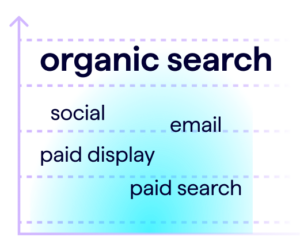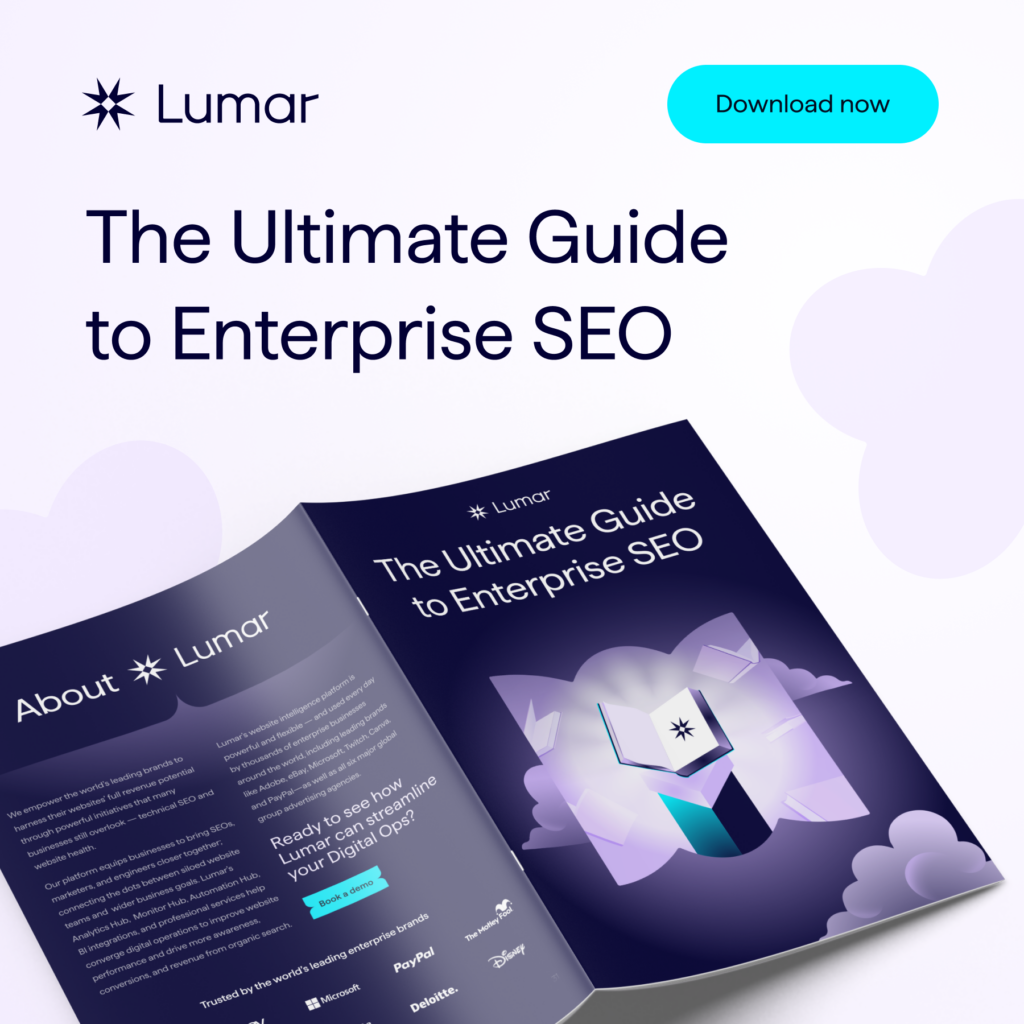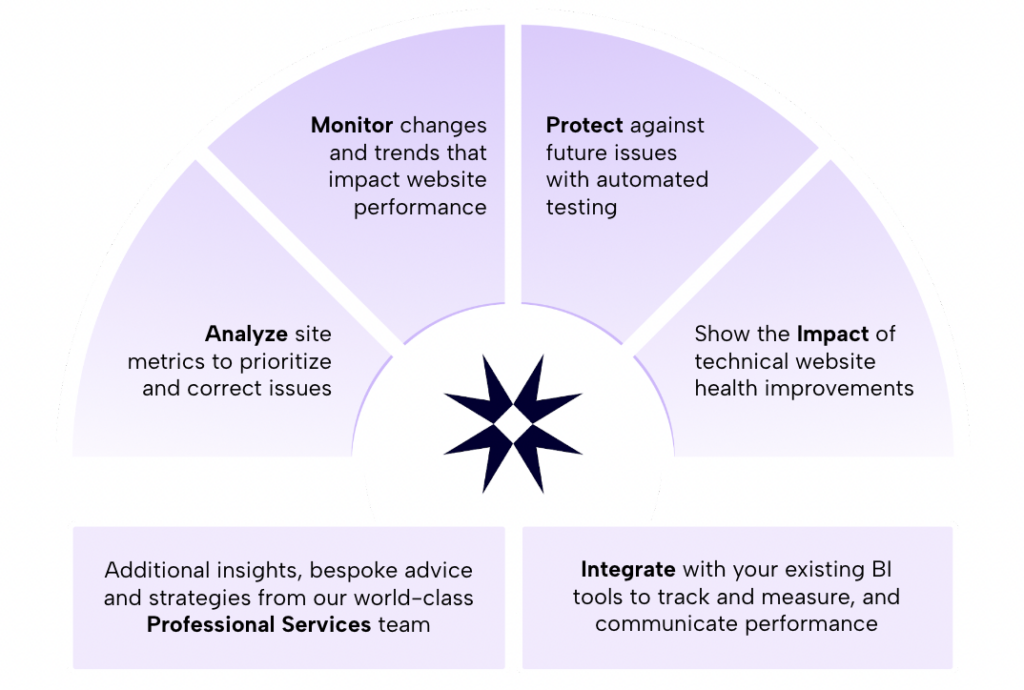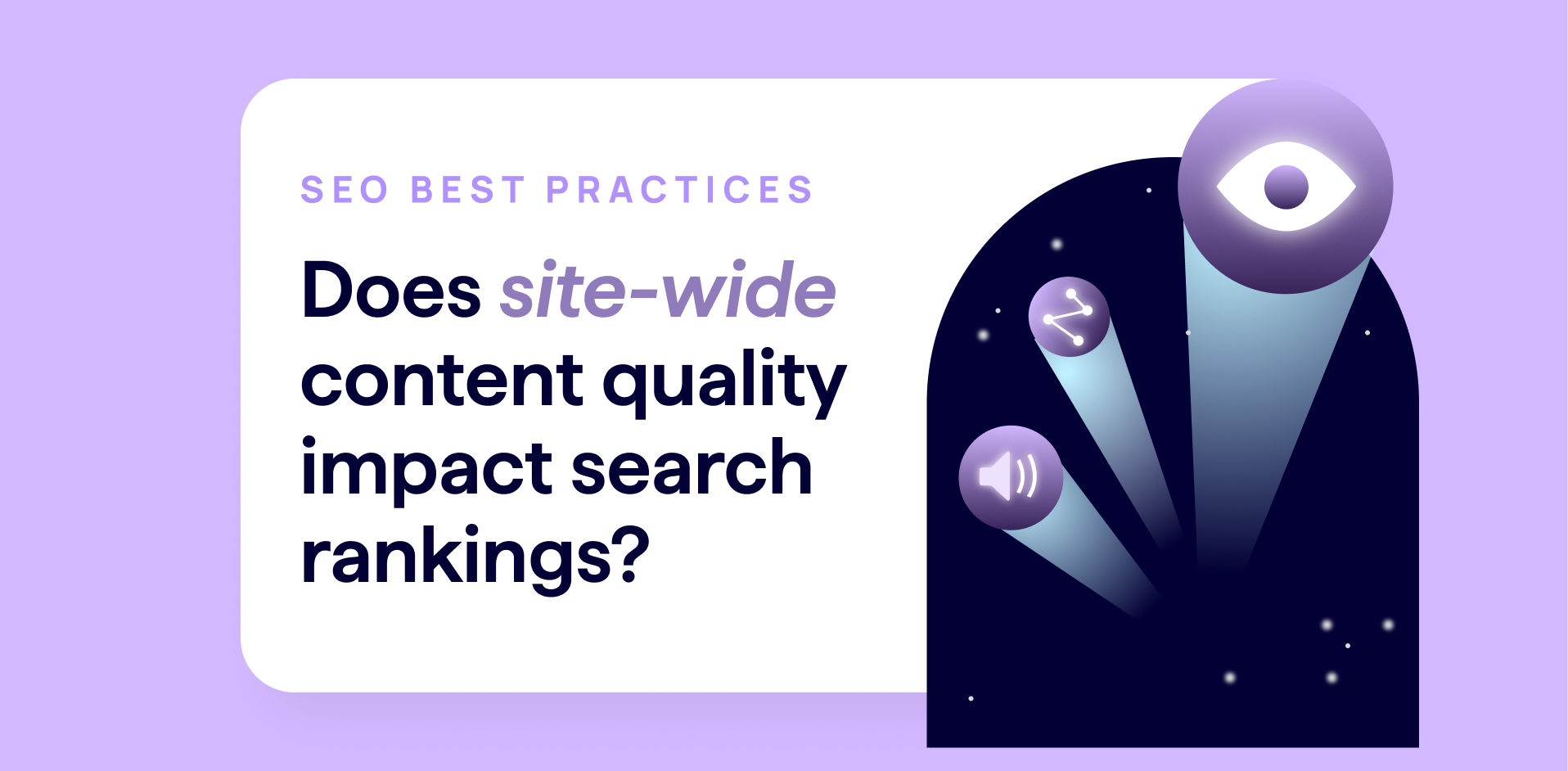Right now, many marketing teams are hard at work exploring which strategies and channels offer the best opportunities for the year ahead. Chances are, your brand’s website and SEO are on your list of marketing considerations for the new year. And with good reason — search engine optimization and website health offer a lot of benefits for businesses seeking to drive more brand awareness and conversions while maintaining effective customer acquisition costs (CAC).
For marketers developing their upcoming channel plans and contemplating their investment in improving their websites’ overall health and performance, we’ve compiled 15 key SEO and website health statistics and data points to keep in mind as you build your marketing strategies.
15 Key SEO & Website Statistics & Data to Know (Summary List)
Want the short version? You got it! (Want more details? See the full commentary, sources, and further explanations below.)
Why SEO & website optimization are key considerations for marketers:
How your website’s technical health influences business goals:
Staying competitive with your brand’s website efforts:
Why SEO and website intelligence are top-of-mind considerations for marketers:

Organic marketing channels (like your brand’s website) are worth prioritizing in times of economic uncertainty, as they offer opportunities to scale brand awareness and conversions without the per-click costs associated with paid channels like online ads.
SEO can help boost brand awareness and help new audiences organically discover your business offering directly within a tool consumers use every day: search engines.
And maintaining a technically sound website offers benefits beyond search engine results as well — fast-loading websites can impact conversion rates and sales, too.
Below, we’ve compiled some key data points that can help you understand the impact and ROI of SEO and website health.
(Note: Taking action to improve your website’s technical health and organic search visibility is easier with the right resources in place — if your website is a priority this year, check out how Lumar’s website intelligence platform can help.)
Here are key data points to keep in mind as you build out your marketing strategies this year:
1) Organic search drives more website traffic than other marketing channels
Studies in recent years have shown that organic search is a primary generator of website traffic.
This percentage will vary by individual site, of course, but often website managers will find that the traffic source generating the most visits to their pages is indeed organic search.
In a HubSpot survey of 400 individual website traffic analysts, the respondents reported that organic search drove more website traffic than social media posts, paid display ads, paid search ads, or email marketing at their organizations.
And in a separate study of 3.25 billion website visits, GrowthBadger found that more than 50% of this website traffic, for most industries, came from organic search.
2) Organic search offers higher click-through rates than paid search ads (27.6% CTR for organic vs. 3.17% CTR for paid)
The top result in Google’s organic search results has an average click-through rate (CTR) of 27.6% percent, according to Backlinko data — compare this to the average 3.17% CTR for paid search ads (across all industries studied) on Google, according to WordStream data.
And this is true of organic search results beyond the top result as well. Pages ranking in positions 1-7 in Google’s organic search results ALL outperform the 3.17% average CTR on paid search ads, according to the Backlinko data.
If earning traffic to your site through consumers’ search results is a priority for your business, it makes sense to not only rely on paid search placements — in addition to not incurring a cost-per-click, earning high positions in Google’s organic results provides higher CTR than paid search ads.
3) Ranking matters: pages in position 1 on Google search receive 81.5% more clicks than pages in position 2 — and 10x the clicks of position 10 results.
- Position 1 CTR: 27.6%
- Position 2 CTR: 15.8%
As we’ve noted above, research looking at 4 million Google search results conducted by Backlinko, found that pages in the number 1 spot in Google’s organic search results generally have a click-through rate of 27.6%.
Compare this to the CTR for pages in position 2 in the organic search results: 15.8%. This data suggests that there can be a 74.7% difference in CTR between position 1 and position 2.
Ranking well in Google and other search engines — a primary goal of SEO — can significantly affect how much traffic lands on your website.
To further drive home that point: Backlinko research also found that the number 1 organic result is 10x more likely to receive a click compared to a page in the number 10 spot.
4) Enhanced SERP features influence CTR (Search results with sitelinks have an average CTR of 46.9% – notably higher than ‘standard’ organic results)
The CTR of organic search results can also be influenced by whether or not your content is displayed in the search engine results pages (SERPs) with or without certain ‘enhanced SERP features’.
Studies have shown that results with sitelinks have a higher CTR than ‘normal’ organic search results. (A Sistrix study found an average 46.9% CTR for results with sitelinks.)
Not sure what ‘sitelinks’ in the SERPs are? Here’s an example of sitelinks appearing in the search results:
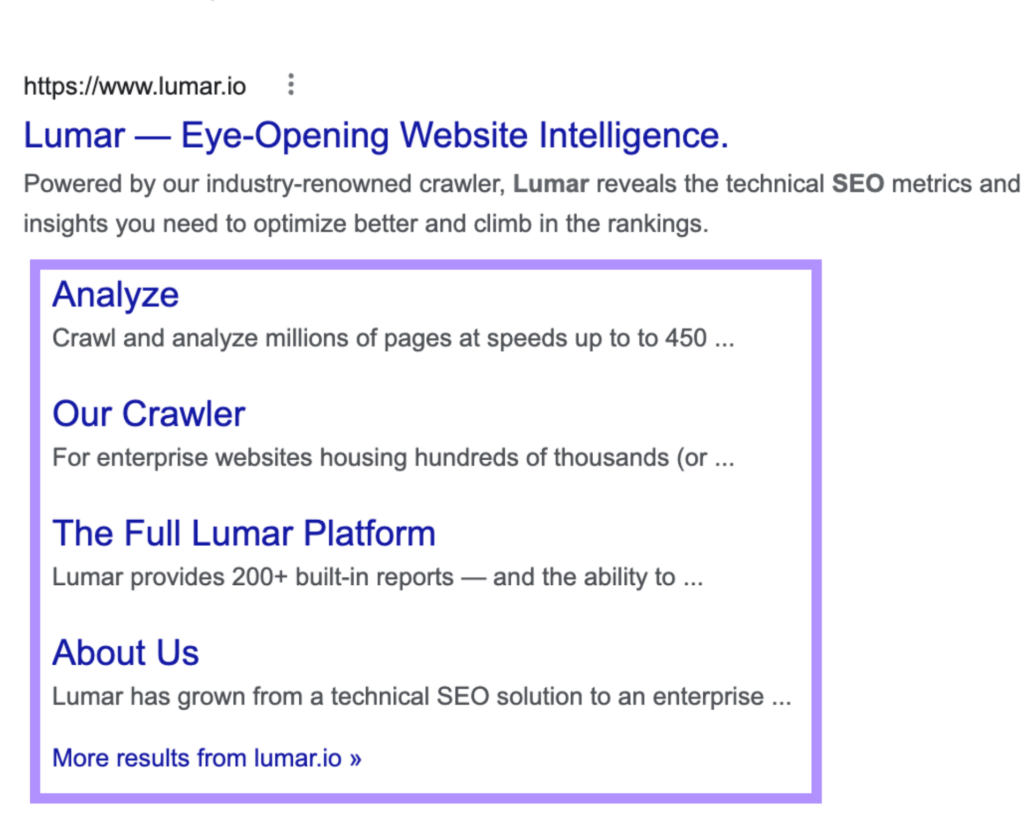
Other enhanced SERP features, however, can actually decrease CTR. This is generally true for search result features that display key information right in the SERP, rather than requiring a user to click through to a page to get the answer they are looking for — in particular, the Sistrix study found that CTR for ‘Featured Snippet’ search results in position one were 5.3% below the average CTR for other result types in the same position.
(Note: the technical health of your website — including its use of structured data — can impact the enhanced SERP features your site gains in Google search results. Having the right website intelligence and technical SEO tools in place can help you monitor and improve your site’s structured data to gain your desired enhanced SERP features.)
5) 89% of marketing leaders surveyed believe organic search will drive more revenue in the years to come
89% of marketing leaders surveyed in our report with Econsultancy felt that organic search would drive more revenue for their organizations in the years to come.
In the survey, nearly half (46%) of respondents estimated that organic search influenced more than a quarter of their organization’s revenue. And more than a quarter (26%) felt it influenced 50% of their organization’s revenue.
Furthermore, of the top performers surveyed, 42% strongly agreed that performing well in organic search results is a key indicator of the overall health of a business. The respondents in the top-performing segment were also more likely to have an efficient strategy in place for monitoring on-site performance, and they reported that their marketing teams had more knowledge regarding SEO than those whose businesses fell outside of the ‘top performer’ category.
6) Organic search & the buyer’s journey: 51% of shoppers surveyed use Google to research the purchases they plan to make online
According to the Google/Ipsos Global Retail Study, more than half of consumers research their purchases using a search engine before hitting ‘buy’.
To help prospective customers through their buyer’s journey during this important ‘consideration’ stage, it can pay to have high-ranking website content that helps guide them.
In a further survey conducted by Think With Google, it’s clear that search (and your website’s overall health and performance) can help influence other stages of the buyer’s journey as well.
Take the ‘awareness’ stage of the customer’s journey — even before a potential customer reaches that ‘consideration’ stage mentioned above, 65% of consumers surveyed said they use search in “I Want to Buy” moments — and 39% said they were influenced to make a purchase by a relevant search. Making sure your website’s content appears in their search results can be a powerful strategy for reaching consumers across their entire journey.
How your website’s technical health influences business goals:

7) Even a 1-second delay in mobile load times can reduce conversion rates by up to 20%.
Site speed matters. That’s because slow website experiences, especially on mobile, can drive away potential customers. Even a one-second delay in mobile load times can reduce conversion rates by up to 20%, according to Mary Ellen Coe, the president of Google Customer Solutions.
8) Page speed matters for both SEO and sales. In a Vodafone case study, they found a 31% improvement in LCP was tied to an 8% increase in sales.
Page speed matters for SEO and for sales. In a Vodafone case study published on Google’s web.dev, they report that Vodafone, a major European telecom company, found that a 31% improvement in LCP was tied to an increase in sales by 8%.
Core Web Vitals, a set of metrics introduced by Google in 2020 and rolled out in 2021, measures three key aspects of the user experience: loading time, interactivity responsiveness, and visual stability.
Within Google’s Core Web Vitals, load time is measured by “Largest Contentful Paint” (LCP). This is the time it takes for the page’s largest image or text block to load and become visible within the viewport (that is, the visible part of a page that users can see within their device or monitor). It’s recommended to have the largest block rendered within 2.5 seconds of the page starting to load.
Slow-loading websites are problematic for several reasons:
- Slow websites are likely to drive away visitors — fewer visitors mean fewer opportunities to convert those visitors into customers.
- Website speed impacts your search rankings. A slow-loading site may rank lower in the SERPs, due to Google’s Core Web Vitals system.
- Slow sites offer a poor customer experience, likely to lead to low levels of engagement.
9) Case Study: A 300ms reduction in load time correlated to 12% more user engagement and 9% more pageviews per session.
Google Search Central reported that Nikkei, a large publisher in Japan, made an effort to address their site’s Core Web Vitals and gained in both user engagement and pageviews per session. A 300-millisecond reduction in Largest Contentful Paint (LCP) correlated to 12% more user engagement and a 9% increase in pageviews per session.
10) Case Study: Utilizing website intelligence tools contributed to a 17% YoY increase in organic traffic
For Cox Automotive, a major enterprise company in the US automotive industry, getting the right website intelligence tools in place for their digital marketing and SEO team made a big difference. The Cox team achieved a 17% YoY increase in organic traffic after leveraging Lumar’s Analyze app.
For Arriva Bus in the UK, using the right website intelligence tools also contributed to a 50% increase in digital conversion alongside an increase in search engine visibility.
Staying competitive with your website efforts:

11) 20% of marketers surveyed saw a significant increase in their budget for organic marketing last year
Companies are investing more in organic marketing. Last year, 20% of marketers surveyed saw a significant increase in their budget for organic marketing (including website and SEO efforts), according to Search Engine Journal. (The number of marketers who saw a significant increase in paid channel budgets, meanwhile, was 13%.)
12) 88% of marketers who have an SEO strategy in place expect to maintain or increase their investment in 2023.
According to HubSpot data, a majority (88%) of marketers with SEO strategies in place expect to either increase or maintain their current level of investment in this key marketing tactic.
13) 53% of marketers who use SEO have a strategy for optimizing videos and images
SEO is not about only keywords and content. Technical SEO is a foundational part of website optimization, and optimizing multimedia content in addition to written content is important. With video content on the rise, it’s worth knowing how to optimize videos for search. According to HubSpot survey data, 53% of marketers who leverage SEO as part of their marketing strategy have processes in place specifically to optimize their videos and images.
14) 66% of enterprise website teams employ 6 or more in-house SEOs (for websites with 10k+ URLs)
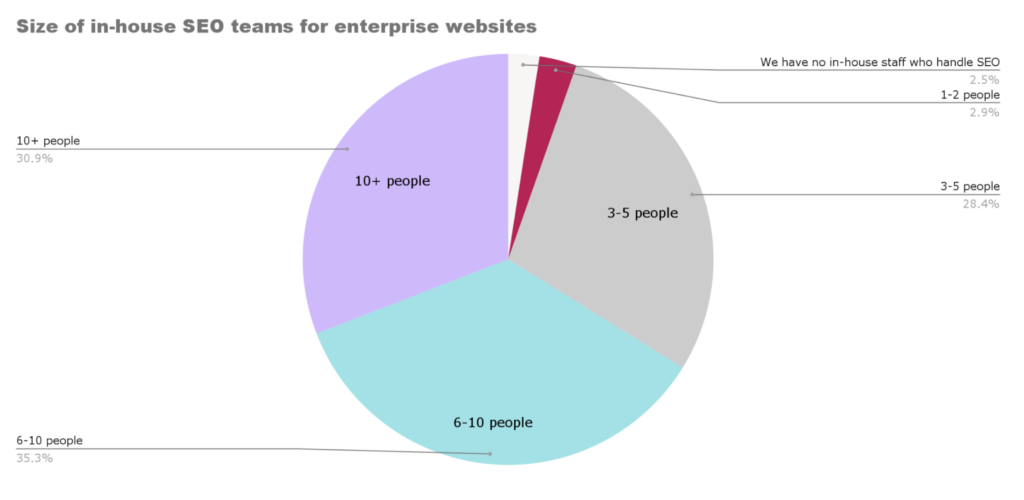
Lumar surveyed 200+ marketing, engineering, and other digital leaders working on enterprise-scale websites (sites with 10,000 or more URLs associated with their websites) to learn more about how they manage SEO and website health.
For these very-large websites, 66% of respondents reported that they employed at least 6 in-house employees who worked on SEO. The full breakdown of SEO team size was:
- 35.3% had SEO teams comprised of 6-10 people.
- 30.9% had SEO teams comprised of 10+ people
- 28.4% had SEO teams comprised of 3-4 people.
- 2.9% had SEO teams comprised of just 1-2 people.
- Only 2.5% of respondents had no dedicated team member in-house who worked on SEO.
15) The biggest SEO challenge for enterprise businesses? Executing improvements and monitoring large sites at scale, according to 60% of executives surveyed.
In a survey conducted by Lumar earlier this year, we asked digital leaders at 200+ companies with large-scale websites what their biggest challenges were when it came to SEO.
Most common website challenges on large-scale websites, according to digital leaders:
- 60% struggled with executing SEO improvements and monitoring at scale across a large website
- 53% struggled with managing SEO tasks across multiple departments
- 46% struggled with improving website speed and UX
- 45% struggled with creating more efficient internal processes for SEO
- 42% struggled with staying up-to-date with the latest developments and best practices in SEO
- 34% struggled with general fixes to existing website SEO problems – for example: broken links, title tags, sitemap updates, etc.
- 32% struggled with creating SEO-friendly website content
- 14% struggled with monitoring website security issues
- 14% struggled with improving website accessibility
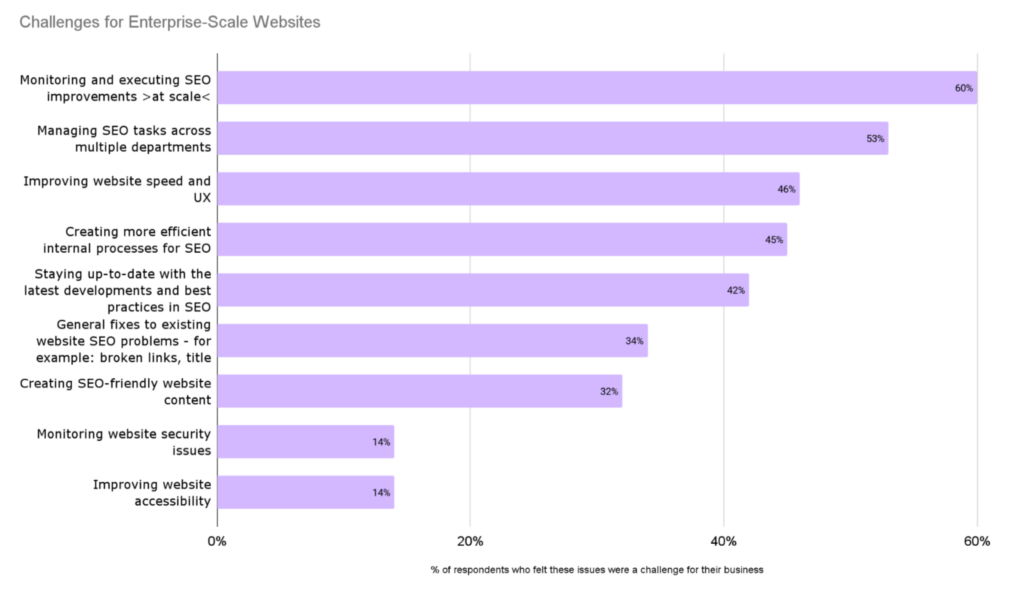
Additional Resources:
See how Lumar can help
If your business is ready to prioritize SEO and your website’s health and performance this year, Lumar can help. Our full suite of website intelligence solutions helps marketers monitor, analyze, test, and track the impact of their website’s technical health and their technical SEO efforts.
Our market-leading website crawler is built for speed and flexibility — so for enterprise websites, you’ll have the insights you need, faster than ever.


